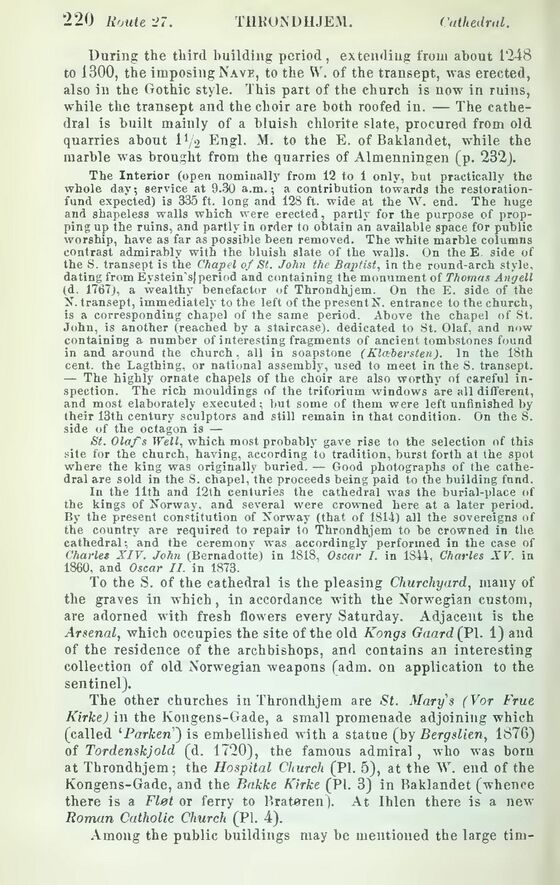
Full resolution (JPEG) - On this page / på denna sida - Norway - Pages ...

<< prev. page << föreg. sida << >> nästa sida >> next page >>
Below is the raw OCR text
from the above scanned image.
Do you see an error? Proofread the page now!
Här nedan syns maskintolkade texten från faksimilbilden ovan.
Ser du något fel? Korrekturläs sidan nu!
This page has never been proofread. / Denna sida har aldrig korrekturlästs.
During the third building period, extending from about 1248
to 1300, the imposing Nave, to the W. of the transept, was erected,
also in the Gothic style. This part of the church is now in ruins,
while the transept and the choir are both roofed in. — The
cathedral is built mainly of a bluish chlorite slate, procured from old
quarries about l1^ Engl. M. to the E. of Baklandet, while the
marble was brought from the quarries of Almenningen (p. 232).
The Interior (open nominally from 12 to 1 only, but practically the
whole day; service at 9.30 a.m.; a contribution towards the
restoration-fund expected) is 335 ft. long and 128 ft. wide at the W. end. The huge
and shapeless walls which were erected, partly for the purpose of
propping up the ruins, and partly in order to obtain an available space for public
worship, have as far as possible been removed. The white marble columns
contrast admirably with the bluish slate of the walls. On the E. side of
the S. transept is the Chapel of SI. John the Baptist, in the round-arch style,
dating from Eystein’sj period and containing the monument of Thomas Angell
(d. 1767). a wealthy benefactor of Throndhjem. On the E. side of the
X. transept, immediately to the left of the present X. entrance to the church,
is a corresponding chapel of the same period. Above the chapel of St.
John, is another (reached by a staircase), dedicated to St. Olaf, and now
containing a number of interesting fragments of ancient tombstones found
in and around the church, all in soapstone (Elabersten). In the 18th
cent, the Lagthing, or national assembly, used to meet in the S. transept.
— The highly ornate chapels of the choir are also worthy of careful
inspection. The rich mouldings of the triforium windows are all different,
and most elaborately executed; but some of them were left unfinished by
their 13th century sculptors and still remain in that condition. On the S.
side of the octagon is —
St. Olaf’s Well, which most probably gave rise to the selection of this
site for the church, having, according to tradition, burst forth at the spot
where the king was originally buried. — Good photographs of the
cathedral are sold in the S. chapel, the proceeds being paid to the building fund.
In the 11th and 12th centuries the cathedral was the burial-place of
the kings of Xorway, and several were crowned here at a later period.
By the present constitution of Xorway (that of 1S14) all the sovereigns of
the country are required to repair to Throndhjem to be crowned in the
cathedral; and the ceremony was accordingly performed in the case of
Charles XIV. John (Bernadotte) in 1818, Oscar I. in 1SA4, Charles XV. in
1860, and Oscar II. in 1873.
To the S. of the cathedral is the pleasing Churchyard, many of
the graves in which, in accordance with the Norwegian cnstom,
are adorned with fresh flowers every Saturday. Adjacent is the
Arsenal, which occupies the site of the old Kongs Gaard (Pl. 1) and
of the residence of the archbishops, and contains an interesting
collection of old Norwegian weapons (adm. on application to the
sentinel).
The other churches in Throndhjem are St. Marys (Vor Frue
Kirke) in the Kongens-Gade, a small promenade adjoining which
(called ‘ Parken) is embellished with a statue (by Bergslien, 1876)
of Tordenskjold (d. 1720), the famous admiral , who was horn
at Throndhjem; the Hospital Church (PI. 5), at the TV. end of the
Kongens-Gade, and the Bakke Kirke (Pl. 3) in Baklandet (whence
there is a Flet or ferry to Brateren). At Ihlen there is a new
Roman Catholic Church (PI. 4).
Among the public buildings may be mentioned the large tim-
<< prev. page << föreg. sida << >> nästa sida >> next page >>